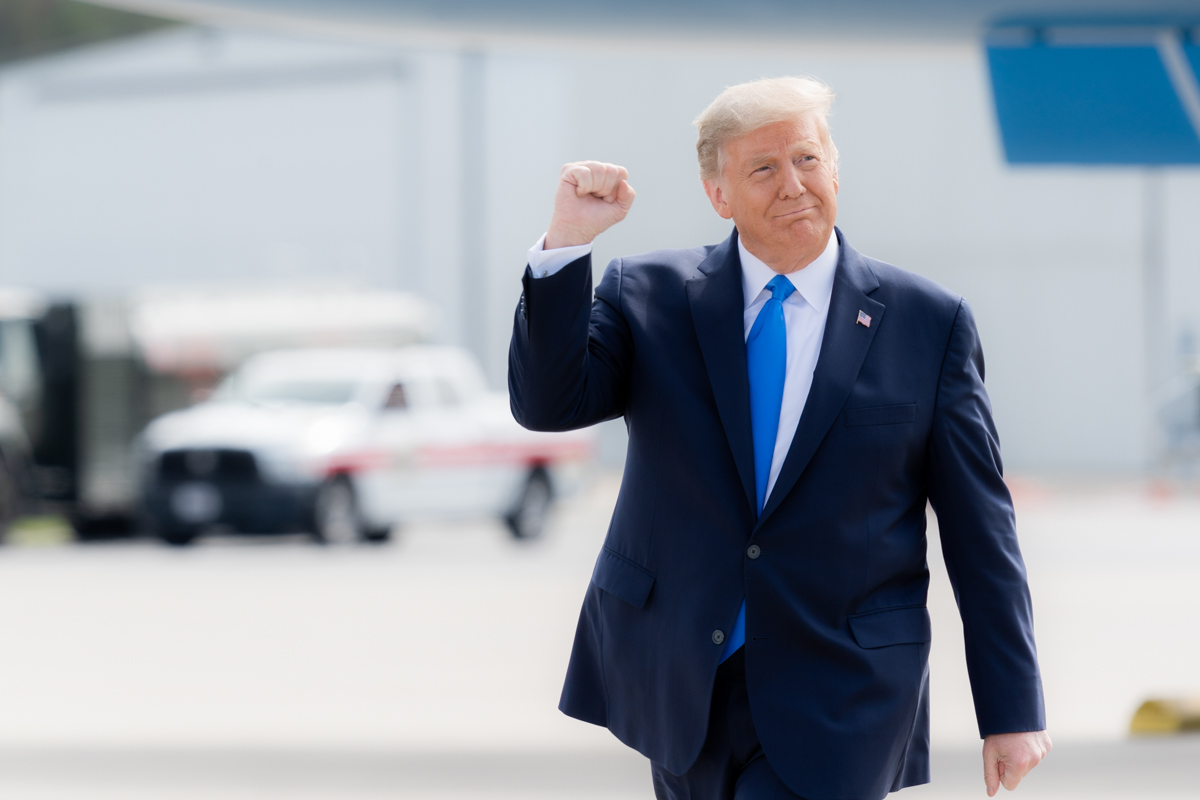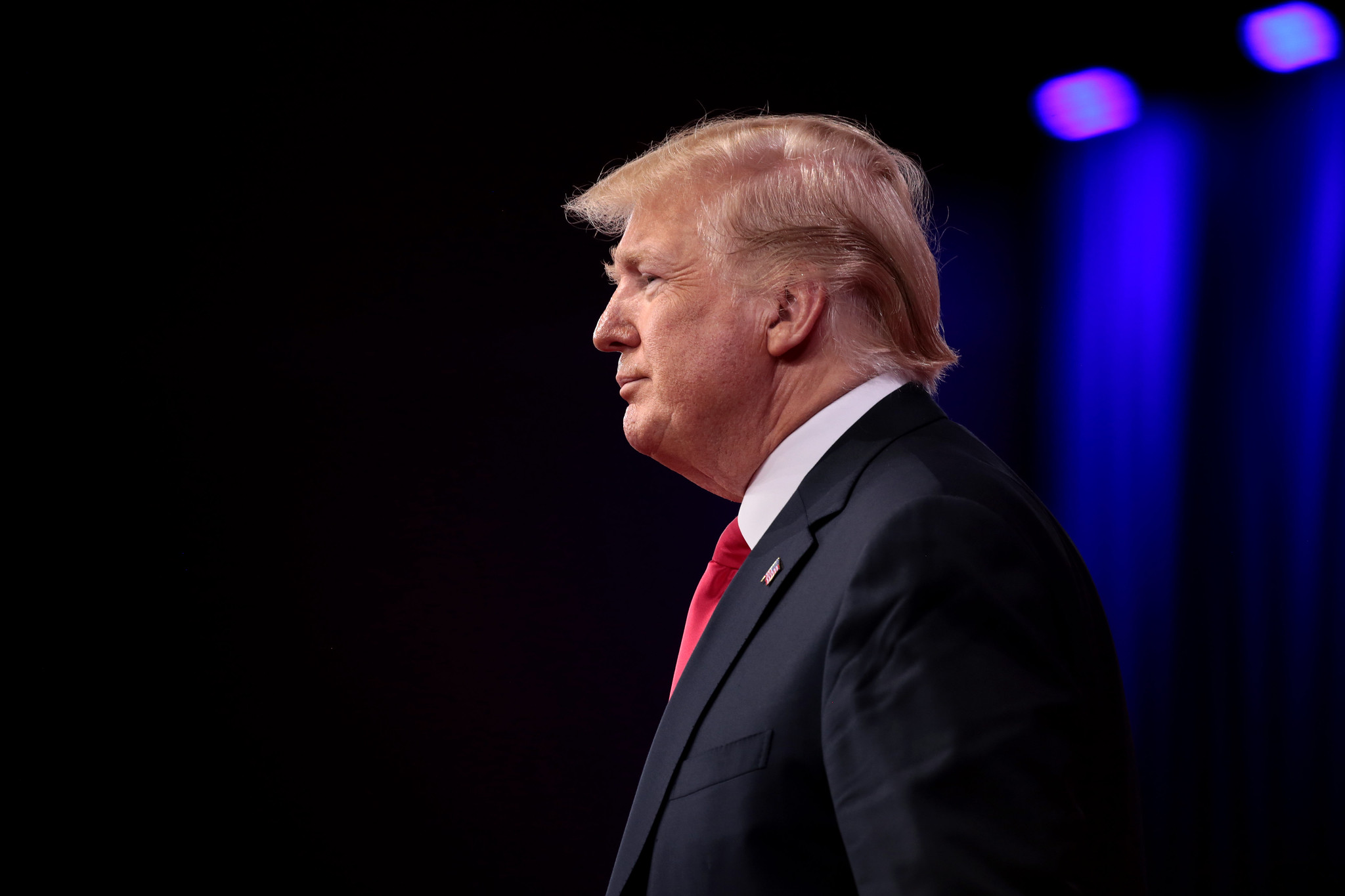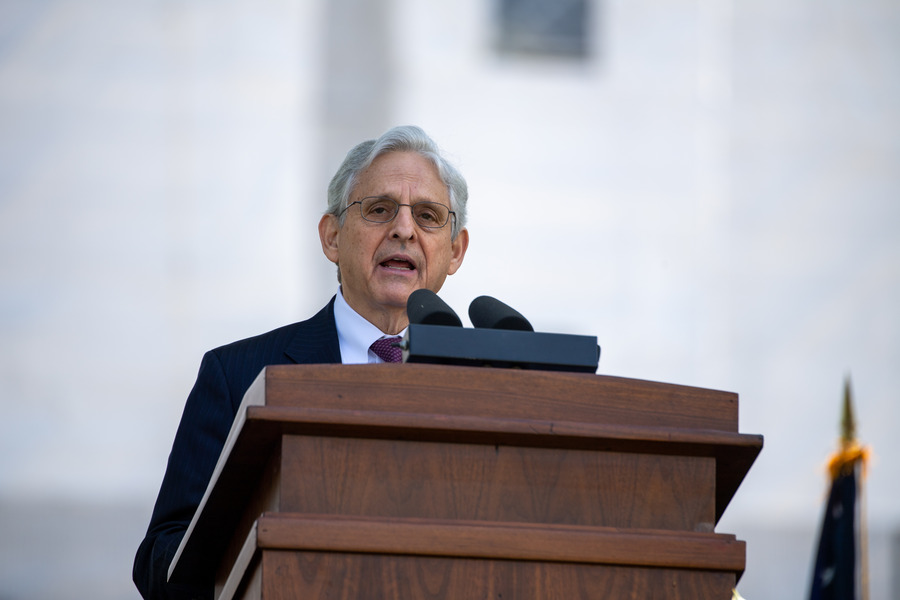A Rule for the Ages, or a Rule for Trump?
The majority opinion in Trump v. United States badly misstates principles of separation of powers to immunize hypothetical future presidents—in service of immunity for Trump himself.

Published by The Lawfare Institute
in Cooperation With

By the time the U.S. Supreme Court finally issued its decision last week in Trump v. United States, addressing former President Trump’s claim of immunity from criminal charges relating to his attempt to subvert the 2020 election, the Court’s delay had already effectively ensured that his trial would not happen before this year’s presidential election. And that, in turn, increased the odds that the trial will never happen at all, that Trump will never face criminal accountability for his conduct. But the substance of the Court’s decision matters far beyond that.
A majority of the Court has now embraced a rule that may make it impossible to prosecute any future president for any official act, no matter how egregious. That is a drastic holding, fundamentally changing the place of the president in our system of laws. Unlike some other commentators, I don’t think the basic separation of powers framework that the majority deployed in its analysis is itself inherently wrong or inapposite. In fact, after the Court granted review in the case, I argued that it should decide the case within that very framework. But Chief Justice John Roberts’s majority opinion made major errors in how it articulated the framework, how it applied (and refused to apply) it, and what it left out. Its blunders are so extreme that it is difficult to escape the conclusion that the majority did what it did not out of concern for the presidency in general, but because it didn’t approve of the charges against Trump in particular.
I.
As Justice Sonia Sotomayor put it in her dissenting opinion in the case (which Justices Elena Kagan and Ketanji Brown Jackson joined), the indictment against Trump “paints a stark portrait of a President desperate to stay in power.” It alleges that, after losing the 2020 presidential election, Trump conspired to overturn it, including by spreading false claims of election fraud, attempting to use the Justice Department to conduct sham investigations, organizing fraudulent slates of electors in multiple states, attempting to persuade then-Vice President Pence to change the election results, and directing a large crowd to go to the U.S. Capitol to obstruct election certification proceedings on Jan. 6, 2021.
The portrait is just as unprecedented as it is stark. Indeed, no incumbent president has ever done anything remotely like what Trump did in late 2020 and early 2021. The ensuing criminal charges against him were also without precedent. In determining whether Trump’s former status as president immunized him from any of those charges, the self-professed originalist majority on the Court would have little to go on, since the constitutional text is silent on presidential immunity. Nor would the Court’s previous cases provide any definitive guide, since it had never before addressed the issue of presidential immunity from criminal charges.
In his majority opinion, Roberts cautioned that the Court must focus on the “enduring consequences” of its decision—or, as Justice Neil Gorsuch dramatically put it during oral argument, on “writing a rule for the ages.” It was critical, then, that the Court decide the case in keeping with foundational principles of our constitutional system, especially the separation of powers, and that it reason by careful analogy from its few past cases on presidential amenability to judicial process. It did not live up to that task.
II.
The rule the Court announced is relatively straightforward to recite, but its scope and application are anything but clear. Roberts’s summary of the rule suggests it may be divided into three propositions (the numbering below is mine):
[1] The President enjoys no immunity for his unofficial acts, and not everything the President does is official. The President is not above the law. But Congress may not criminalize the President’s conduct in carrying out the responsibilities of the Executive Branch under the Constitution . . . . [2] The President therefore may not be prosecuted for exercising his core constitutional powers, and [3] he is entitled, at a minimum, to a presumptive immunity from prosecution for all his official acts.
It is worth considering each proposition in turn.
1. The president has no immunity for his unofficial acts.
This might seem like a noteworthy concession to the prosecution, but no one has ever suggested anything to the contrary. Even Trump’s lawyers agreed that the president is not immune for his private acts.
But after setting out this unremarkable proposition, Roberts declined to apply it. He did not concede that any of the allegations in the indictment actually involve private, unofficial conduct. This is one of several key places where Justice Amy Coney Barrett, who joined most of Roberts’s opinion but also issued a separate concurrence, parted company with the majority, writing that “sorting private from official conduct sometimes will be difficult—but not always.” One easy case in her view (and in the view of the three dissenters) is Trump’s alleged attempt to organize fraudulent slates of electors. Because the Constitution gives the president no role whatsoever in the appointment of presidential electors, Barrett reasoned, “a President has no legal authority—and thus no official capacity—to influence how the States appoint their electors.” Accordingly, Barrett saw “no plausible argument for barring prosecution of that alleged conduct.”
Roberts and the rest of the majority did not expressly disagree with Barrett on this point. Rather, they simply left application of the rule to the lower courts in the first instance. That is a common maneuver: The Supreme Court often announces a rule and then leaves it to the lower courts to work out how the rule should be applied to certain facts. But this is no ordinary case, and by refusing to agree with their colleagues on even this seemingly easy application, Roberts and the rest of the majority left open the possibility that it could come out the other way. If that were to happen, the notion of non-immunity for personal conduct could become practically irrelevant. The scope of personal as opposed to official acts would shrink to the vanishing point.
2. The president is absolutely immune from criminal prosecution for conduct within his exclusive constitutional authority.
As I have argued, this proposition is well grounded in the Court’s separation of powers precedents, including Justice Robert Jackson’s influential concurring opinion in the 1952 case, Youngstown Sheet & Tube Co. v. Sawyer. As Jackson explained, and as multiple Court majorities have recognized, there are some matters over which the Constitution grants the president exclusive authority such that Congress may not act on them. Uncontroversial examples include the power to grant pardons, to veto legislation, to nominate federal officers, and to recognize foreign governments, among others. If Congress may not regulate the exercise of those presidential powers, it follows that Congress may not criminalize them either.
So far, so good. But having recognized the concept of certain limited zones of exclusive presidential authority, the majority then applied it in an astonishingly expansive way. (Notably, this is the only part of its rule that the majority saw fit to apply to the charges in this case. It made no attempt to explain why it did so here but not elsewhere.) Specifically, it held that Trump’s alleged attempt to use the Justice Department to pressure states to change their election results involved conduct within Trump’s “conclusive and preclusive” authority. The reasoning in this part of the opinion is not especially clear, but it appears to be sweeping. To be sure, the idea that some aspects of the president’s interactions with the Justice Department leadership might fall within his exclusive authority is not new. For example, the Court has held that the president must have unfettered power to remove high-ranking executive officials whom he has appointed. Thus, Trump cannot be prosecuted for threatening to remove the acting attorney general when he refused to go along with efforts to use the department to advance Trump’s election subversion plans.
But the majority went much further than that. It announced that the president has “exclusive authority over the investigative and prosecutorial functions of the Justice Department and its officials” and that “Trump is therefore absolutely immune from prosecution for the alleged conduct involving his discussions with Justice Department officials.” It is one thing to say that the president has broad power to supervise Justice Department leadership. But it is quite another to suggest that every interaction between the president and any given Justice Department official lies within a zone of exclusive presidential authority. The more conventional understanding would have been that Congress—whose legislation created, authorizes, and funds the Justice Department—and the president each have some authority in this space, and that they overlap in ways that make some aspects of the president’s interactions with the department subject to congressional regulation. For example, although the president possesses considerable power to set the enforcement priorities of the department, surely Congress could influence those priorities by appropriating funds for certain areas of law enforcement and not others, or by setting enforcement priorities within the legislation that authorizes the department to act in the first place. Did Roberts mean to suggest that the president has the exclusive, unregulable authority to violate appropriations laws and allocate funds to the Justice Department that Congress has not provided? That would be totally unsupportable. I assume Roberts did not mean to go that far, but he provided no clear limiting principle in what he did say.
To make matters worse, the majority at one point gestured toward the president’s constitutional responsibility to “take Care that the Laws be faithfully executed” as a basis for the idea that Congress may not regulate his interactions with the department. (Barrett made clear that she did not think the Take Care Clause could bear such weight.) The president’s “Take Care” responsibility is not limited to the activities of the Justice Department; it stretches across every part of the executive branch that enforces federal law of any kind. Did Roberts therefore mean to say that the president is absolutely immune from criminal responsibility for all of his interactions with every employee of the executive branch, no matter the context, no matter the purpose, no matter the result? That would be astonishing. But once again, the reader will look in vain for any effort by the majority to cabin its reasoning.
In short, the majority took the valid concept of a limited sphere of exclusive presidential authority and stretched it beyond recognition. After refusing to apply the rule of non-immunity for personal acts to any of the allegations in the indictment, the majority articulated and applied a sweeping view of the president’s exclusive constitutional authorities, unnecessarily casting doubt on Congress’s authority over vast swaths of the federal government.
3. For all official presidential actions falling outside the president’s exclusive authority, the president enjoys at least a presumption of immunity.
This is the most significant part of the Court’s decision, and also the least justified. Nothing in the constitutional text, the Court’s precedents, or the federal government’s historical practice dictated this rule. It is simply the result of the majority’s policy determination to set the line where it did: at least presumptive, and potentially absolute, immunity from criminal liability for everything the president does in his official capacity. If the immunity turns out to be absolute, the American legal system will be incapable of policing blatant crimes by the most powerful official in our democratic system. The fact that the majority saw no need to disclaim that result is itself stunning.
The majority did, however, describe what it thought the government would need to do to rebut the presumption of immunity, if indeed it is rebuttable. As Roberts put it, the government must show that applying a criminal statute to the official presidential act in question would pose no “dangers of intrusion on the authority and functions of the Executive Branch.” There are many problems with this standard. First, “no dangers” is an extremely high bar. It is hard to see how the government could prove that any given charge against a former president posed no risk of intruding even one iota on the functions of the executive branch. The majority provided no guidance on how or in what circumstances the government could possibly prove that negative.
Second, the majority drew this language from Nixon v. Fitzgerald, which involved a former president’s immunity from civil suits for damages. Yet in a move that can only be called brazenly dishonest, Roberts quoted only part of the key sentence in Fitzgerald. Here is what that Court said: “[A] court, before exercising jurisdiction, must balance the constitutional weight of the interest to be served against the dangers of intrusion on the authority and functions of the Executive Branch.” Fitzgerald portrayed the key inquiry as a balancing test: Weigh the interest served by immunity (protecting against intrusions on the executive branch) against the interest served by allowing the case to move forward (vindicating the values served by the law being invoked). Applied in this context, the judiciary’s task would be to balance potential intrusions on the presidency against the public interest in upholding the criminal law and the rule of law more generally. But Roberts’s majority opinion all but ignored the other side of the scales, pretending there was nothing to balance. The result is not only an absolutist rebuttal standard that might be impossible to satisfy, but one of the majority’s own invention, based on a distortion of the precedent it invoked.
If the Court were truly interested in adhering to the principles of its separation of powers jurisprudence, there was a much more straightforward path to take. Once we leave the zone of exclusive presidential power, we enter an area where the authorities of Congress and the president overlap—what Jackson famously referred to in Youngstown as a “zone of twilight.” As Jackson explained, difficult questions can arise in this space when the president acts in the absence of congressional approval or disapproval. But that is not the issue here. Once we are outside the zone of exclusive presidential authority, we are in an area where Congress is presumed competent to act, and thus where the president’s conduct is subject to regulation by Congress. I emphasized that point in my earlier piece on this case, and Barrett made the same point in her concurrence: “[T]he Constitution does not vest every exercise of executive power in the President’s sole discretion. ... Congress has concurrent authority over many Government functions, and it may sometimes use that authority to regulate the President’s official conduct, including by criminal statute.”
On this understanding, there should be no general immunity for official presidential acts falling outside the limited zone of exclusive presidential authority (and perhaps, Barrett suggested, other acts closely related to that zone). Indeed, in areas outside the president’s exclusive responsibility and instead subject to concurrent congressional and presidential authority, I see no basis for a presumption of immunity at all. If anything, the presumption should run the other way: In areas where executive action is subject to congressional regulation, Congress should generally be able to regulate that action by criminal statute if it chooses. There is no basis in the separation of powers to exclude presidential conduct from that understanding.
Of course, as Barrett pointed out, the government would need to clear other hurdles before being able to prosecute a former president for any official act. Perhaps most significantly, it would need to establish that the law he is charged with violating actually applies to the president while in office. Not all laws of general application cover the president. A law that regulates federal agencies, for example, does not necessarily cover the president because he, as head of the executive branch, is not naturally deemed an agency of that branch. Over time, as Jack Goldsmith has explained, the courts have evolved certain interpretive techniques designed to make sure that they do not apply federal laws against the president if it would unduly impinge upon the separation of powers (a much more manageable standard for the prosecution than Roberts’s “no danger” test), unless it is clear that Congress intended such a result. Those techniques are themselves a significant protection of the presidency.
Barrett’s approach again went where the majority would not: She concluded that certain of Trump’s alleged official acts could be prosecuted. She pointed to the charges that Trump asked the leader of the Arizona state legislature to hold a special hearing to look into Trump’s claims of election fraud, all in an unlawful effort to subvert the election results in that state. As Barrett put it, “[t]he President has no authority over state legislatures or their leadership, so it is hard to see how prosecuting him for crimes committed when dealing with the Arizona House Speaker would unconstitutionally intrude on executive power.” That conclusion is entirely in keeping with the vision of the separation of powers embraced by the Court’s prior cases.
It may be technically possible to read Barrett’s approach as compatible with the majority’s. Barrett evidently thought so; she styled her opinion a concurrence while also joining the bulk of the majority opinion. But in tone, analytical structure, and willingness to apply the relevant standard to the particularities of Trump’s case, the two opinions vary greatly. A majority opinion that followed Barrett’s guideposts would have stood on the solid foundation of the Court’s separation of powers precedents. It would have protected core presidential prerogatives under the Constitution without granting the president any general exemption from legal accountability. One suspects that it may have even garnered support among some of the dissenters. But to become the opinion of the Court, it needed at least one other member of the majority to join it. None of them did.
III.
Justice Sotomayor wrote the principal dissent. Whereas the majority distanced itself from the case at hand—“we cannot afford to fixate exclusively, or even primarily, on present exigencies”—Sotomayor’s immediate concern was with the indictment in Trump v. United States itself. The majority, she wrote, “gives former President Trump all the immunity he asks for and more.” She characterized the allegations against Trump as implicating constitutional values of the first order—namely, the “Executive Branch’s interest in upholding Presidential elections” and “the voters’ interest in democratically selecting their President.” Strikingly, Roberts never really came to grips with these dimensions of the case.
Of course, Sotomayor was well aware that the Court’s decision would have implications far beyond the case at hand, and she spent a great deal of her dissent analyzing them. She disagreed strongly with the majority’s standard for official conduct immunity, which she took to be either literally or practically irrebuttable:
When [the president] uses his official powers in any way, under the majority’s reasoning, he now will be insulated from criminal prosecution. Orders the Navy’s Seal Team 6 to assassinate a political rival? Immune. Organizes a military coup to hold onto power? Immune. Takes a bribe in exchange for a pardon? Immune. Immune, immune, immune.
That the majority neither owned nor disclaimed those consequences is itself both striking and chilling.
What did Roberts say about Sotomayor’s criticisms (and the criticisms of a separate dissent by Justice Jackson)? Not much. Rather than engaging them on the merits, he dismissed them as “fear mongering on the basis of extreme hypotheticals.” According to Roberts, “[t]he dissents overlook the more likely prospect of an Executive Branch that cannibalizes itself, with each successive President free to prosecute his predecessors, yet unable to boldly and fearlessly carry out his duties for fear that he may be next.” This may be the majority’s ultimate tell.
If Roberts and others in the majority were truly focused on striking the right future balance between presidential prerogative and the rule of law, Barrett’s approach should have carried the day. She saw the importance of ensuring that the president can act within zones of his exclusive discretion but also recognized that Congress has a role to play in structuring and regulating much executive conduct. It is possible to protect the president’s role in our constitutional system while also allowing that certain elements of the indictment against Trump could go forward without intruding on that role.
IV.
What could have led the majority to take the path it did? It is hard to resist the conclusion that the impetus for its dramatic misapplication of separation of powers principles was an underlying hostility to this very case—the one from which it purported to distance itself with protestations that it cannot fixate on “present exigencies” or focus on “transient results.”
The majority’s new presidential immunity standard may very well insulate Trump entirely from this prosecution. The majority explicitly prohibited some of the charges against him. It made others potentially unsustainable by inventing a standard of presumptive immunity that may be impossible to rebut. And it declined to evaluate whether any of the indictment’s allegations involve unofficial conduct, refusing even to acknowledge, let alone rebut, Barrett’s and Sotomayor’s explanations as to why some of the charged conduct could not be understood otherwise. Under the pretense of protecting future presidents from unknown hypothetical charges, the majority may well have killed this case. And it has, at a minimum, introduced significant uncertainty into the three other criminal cases pending against Trump. All of this may have been the idea.
Despite the indictment’s detailed allegations of Trump’s outrageous and illegal attempts to subvert the results of the election, the majority evidently saw little harm in rendering the case against Trump practically unsustainable. Indeed, for all its worrying about the future “prospect of an Executive Branch that cannibalizes itself,” it seems the majority saw this very case as already entailing a set of prosecutorial decisions it could not abide. The problem, from this point of view, is not that Trump and his allies repeatedly tried to overthrow the 2020 election by unlawful means. It is not that he nearly upended our democracy. It is that the Justice Department is trying to hold him to account for doing so.





